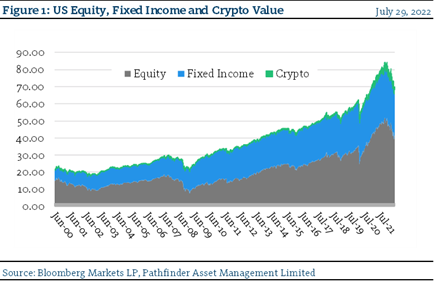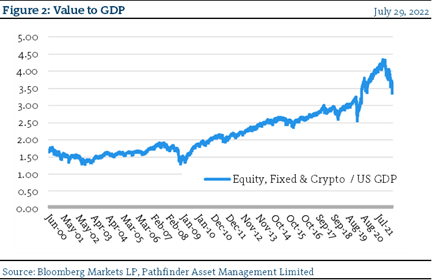Bonds really matter
We begin a series for August that will explore the change in aggregate market value that has occurred over the past 6 months. While the headlines from the financial press have captured the drop in markets since the beginning of the year, they tend to follow those stories that will generate the most readership. Thus, most people will have heard about the drop in equities, the drop in crypto assets and the play-by-play of what Elon Musk is up to, but there is a less publicized issue of the aggregate impact of fixed income on the overall market. Bonds are just not that exciting; nonetheless, they have serious implications for all investors. We present US data below for the first half of the year. It is a compilation of the Russell 3000 index and indices from Bloomberg Markets LP: the US Microcap Index, the US Aggregate Government Bond Index, US Corporate High Yield Index and US Municipal Bond index. We also added composite crypto data from CoinGeko. All told, the data include 4,667 equity securities, 70,898 fixed income securities and 13,107 crypto coins representing US$ 69.2 Trillion in assets as of the end of June, 2022.
- In Figure 1, we can see that the data started in early 2000 at just over $US 20 Trillion and increased to a peak of $85.5T in Dec of 2021.
- It is hard to see from the chart (and we will explore this further in coming issues), but in 2008, there was $8T loss of wealth from top to bottom. So far in this bear market, we have lost $16.3T of value, a little more than twice the value from the Great Financial Recession (GFR). A major contributor to this is fixed income. This is different than what we experienced in the GFR.

- The US economy is bigger now than in 2008 so Figure 2 normalizes the difference between the values in Figure 1 and the US economy. You can see that even with the huge adjustment in valuation and the economic growth, we are still at the higher end of the value of financial assets in relation to the economy.

“This means that” we are just at the start of this study so we will hold onto our conclusions, but will continue to update the data as we progress through the study.
National Instrument 31-103 requires registered firms to disclose information that a reasonable investor would expect to know, including any material conflicts with the firm or its representatives. Doug Johnson and/or Pathfinder Asset Management Limited are an insider of companies periodically mentioned in this report. Please visit www.paml.ca for full disclosures.
*All returns are time weighted and net of investment management fees. Returns from the Pathfinder Partners’ Fund and Partners’ Real Return Plus Fund are presented based on the masters series of each fund. The Pathfinder Core: Equity Portfolio and The Pathfinder Core: High Income Portfolio are live accounts. These are actual accounts owned by the Pathfinder Chairman (Equity) and client (High Income) which contain no legacy positions, cash flows or other Pathfinder investment mandates or products. Monthly inception dates for each fund and portfolio are as follows: Pathfinder Core: Equity Portfolio (January 2011), Pathfinder Core: High Income Portfolio (October 2012) Partners’ Fund (April 2011), Partners’ Real Return Plus Fund (April, 2013), and Partners’ Core Plus Fund (November 2014).
Pathfinder Asset Management Limited (PAML) and its affiliates may collectively beneficially own in excess of 10% of one or more classes of the issued and outstanding equity securities mentioned in this newsletter. This publication is intended only to convey information. It is not to be construed as an investment guide or as an offer or solicitation of an offer to buy or sell any of the securities mentioned in it. The author has taken all usual and reasonable precautions to determine that the information contained in this publication has been obtained from sources believed to be reliable and that the procedures used to summarize and analyze such information are based on approved practices and principles in the investment industry. However, the market forces underlying investment value are subject to sudden and dramatic changes and data availability varies from one moment to the next. Consequently, neither the author nor PAML can make any warranty as to the accuracy or completeness of information, analysis or views contained in this publication or their usefulness or suitability in any particular circumstance. You should not undertake any investment or portfolio assessment or other transaction on the basis of this publication, but should first consult your portfolio manager, who can assess all relevant particulars of any proposed investment or transaction. PAML and the author accept no liability of any kind whatsoever or any damages or losses incurred by you as a result of reliance upon or use of this publication.